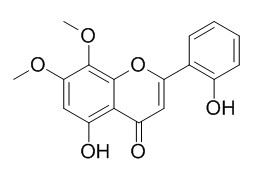Skullcapflavone I
Skullcapflavone I has anti-inflammatory and anti-allergic potential, it can significantly inhibit LPS stimulated NO and PGE(2) release in J774A.1 macrophages and inhibit LPS induced IL-6 production in a concentration dependent manner. Skullcapflavone I selectively induces apoptosis in T-HSC/Cl-6 cells via caspase-3 and caspase-9 activation.
Inquire / Order:
manager@chemfaces.com
Technical Inquiries:
service@chemfaces.com
Tel:
+86-27-84237783
Fax:
+86-27-84254680
Address:
1 Building, No. 83, CheCheng Rd., Wuhan Economic and Technological Development Zone, Wuhan, Hubei 430056, PRC
Providing storage is as stated on the product vial and the vial is kept tightly sealed, the product can be stored for up to
24 months(2-8C).
Wherever possible, you should prepare and use solutions on the same day. However, if you need to make up stock solutions in advance, we recommend that you store the solution as aliquots in tightly sealed vials at -20C. Generally, these will be useable for up to two weeks. Before use, and prior to opening the vial we recommend that you allow your product to equilibrate to room temperature for at least 1 hour.
Need more advice on solubility, usage and handling? Please email to: service@chemfaces.com
The packaging of the product may have turned upside down during transportation, resulting in the natural compounds adhering to the neck or cap of the vial. take the vial out of its packaging and gently shake to let the compounds fall to the bottom of the vial. for liquid products, centrifuge at 200-500 RPM to gather the liquid at the bottom of the vial. try to avoid loss or contamination during handling.
Appl. Sci.2023, 13(17), 9653.
Planta Med.2019, 85(4):347-355
Cells.2023, 12(3):395.
Int J Mol Sci.2023, 24(17):13230.
Processes2024, 12(8), 1563
Anticancer Res.2018, 38(4):2127-2135
Molecules.2022, 27(19):6681.
Evid Based Complement Alternat Med.2020, 2020:8582318.
Pharmaceuticals (Basel).2020, 13(10):302.
Microbiol. Biotechnol. Lett.2022, 50(2): 193-201.
Related and Featured Products
Viscidulin II
Catalog No: CFN92214
CAS No: 92519-93-2
Price: Inquiry(manager@chemfaces.com)
5,2',6'-Trihydroxy-6,7,8-trimethoxyflavone
Catalog No: CFN92215
CAS No: 98187-98-5
Price: Inquiry(manager@chemfaces.com)
Rivularin
Catalog No: CFN92217
CAS No: 70028-59-0
Price: Inquiry(manager@chemfaces.com)
Skullcapflavone II
Catalog No: CFN92216
CAS No: 55084-08-7
Price: $218/10mg
3',5,5',7-Tetrahydroxy-4',6-dimethoxyflavone
Catalog No: CFN99369
CAS No: 125537-92-0
Price: Inquiry(manager@chemfaces.com)
5,7,3'-Trihydroxy-6,4',5'-trimethoxyflavone
Catalog No: CFN90939
CAS No: 78417-26-2
Price: Inquiry(manager@chemfaces.com)
3'-Hydroxy-5,7,4',5'-Tetramethoxyflavone
Catalog No: CFN95397
CAS No: 29976-51-0
Price: $318/5mg
Tricetin
Catalog No: CFN70392
CAS No: 520-31-0
Price: $118/10mg
Tricin
Catalog No: CFN98841
CAS No: 520-32-1
Price: $258/10mg
Salcolin A
Catalog No: CFN95965
CAS No: 1977557-69-9
Price: $318/5mg
Planta Med. 2005 Sep;71(9):885-7.
Skullcapflavone I from Scutellaria baicalensis induces apoptosis in activated rat hepatic stellate cells.[Pubmed:
16206047]
The therapeutic goal in liver fibrosis is the reversal of fibrosis and the selective clearance by apoptosis of hepatic stellate cells (HSCs), which play a central role in liver fibrogenesis.
METHODS AND RESULTS:
In this study, the apoptotic effect of wogonin, oroxylin A, 2',5,6',7-tetrahydroxyflavone, Skullcapflavone I, and baicalein, isolated from the dried root of Scutellaria baicalensis, was investigated in activated rat HSCs, T-HSC/Cl-6 cells transformed with the Simian virus 40. Among the isolated compounds, Skullcapflavone I (20 microM for 24 h) significantly induced apoptosis in activated rat HSCs while there was no change in the cell viability of hepatocytes. Skullcapflavone I increased caspase-3 and -9 activities accompanied by the proteolytic cleavage of poly(ADP-ribose) polymerase. Specific inhibitors of caspase-3 and caspase-9 prevented the apoptotic process induced by Skullcapflavone I.
CONCLUSIONS:
From these results, Skullcapflavone I from S. baicalensis selectively induced apoptosis in T-HSC/Cl-6 cells via caspase-3 and caspase-9 activation.
Int Immunopharmacol. 2011 Jan;11(1):79-84.
In vitro modulation of LPS/calcimycin induced inflammatory and allergic mediators by pure compounds of Andrographis paniculata (King of bitters) extract.[Pubmed:
21034865]
METHODS AND RESULTS:
The aim of the current study is to probe the anti-inflammatory/anti-allergic potential of seven phytoconstituents (andrographolide, neoandrographolide, isoandrographolide, andrograpanin, 14-deoxy-11,12-didehydroandrographolide, 7-O-methylwogonin and Skullcapflavone I) isolated from Andrographis paniculata (King of bitters) on the production of key inflammatory/allergic mediators (NO, PGE(2), IL-1 beta, IL-6, LTB(4), TXB(2) and histamine).
The results demonstrated that andrographolide, isoandrographolide, 7-O-methylwogonin and Skullcapflavone I significantly inhibited LPS stimulated NO and PGE(2) release in J774A.1 macrophages. Andrographolide, isoandrographolide and 7-O-methylwogonin showed considerable inhibition of IL-1 beta production in LPS elicited macrophages. LPS induced IL-6 production was significantly inhibited by andrographolide, isoandrographolide and Skullcapflavone I in a concentration dependent manner. The results revealed that andrographolide, isoandrographolide and Skullcapflavone I significantly decreased TXB(2) release in A23187 activated HL-60 promyelocytic cells. Furthermore, the anti-allergic properties of the phytoconstituents was investigated on A23187 induced LTB(4) production (HL-60 cells) and histamine release (RBL-2H3 basophilic cells). The results showed that only Skullcapflavone I and 7-O-methylwogonin showed marked inhibitory effect on LTB(4) production, however, only 7-O-methylwogonin exerted dose-dependent inhibition towards histamine release.
CONCLUSIONS:
Therefore, this study indicates that some of these phytoconstituents exhibit potent anti-inflammatory/anti-allergic effects by modulating different inflammatory/allergic mediators. Hence, these phytoconstituents might provide useful phytomedical treatment against variety of inflammatory and allergic disorders.



